MAN308: Report on Customer Benefits Packages and Value Chain Designs
VerifiedAdded on 2023/01/13
|13
|4214
|95
Report
AI Summary
This report provides a comprehensive analysis of customer benefits packages and value chain designs, focusing on a comparative study of Apple Inc. and Verizon Wireless. The introduction highlights the importance of the value chain in an organization and its impact on customer satisfaction. The report describes, compares, and contrasts the customer benefits packages offered by both companies, examining how they meet customer needs and provide value. Furthermore, the report delves into the value chain design and structure of each organization, differentiating between rational and market value chain designs, and evaluating the advantages and disadvantages of each approach from both customer and management perspectives. The analysis includes an examination of how each firm defines its operations strategy, including strategic vision, strategy, and competitive priorities. The report concludes by comparing and contrasting the two organizations, offering insights into their operational approaches and strategies.
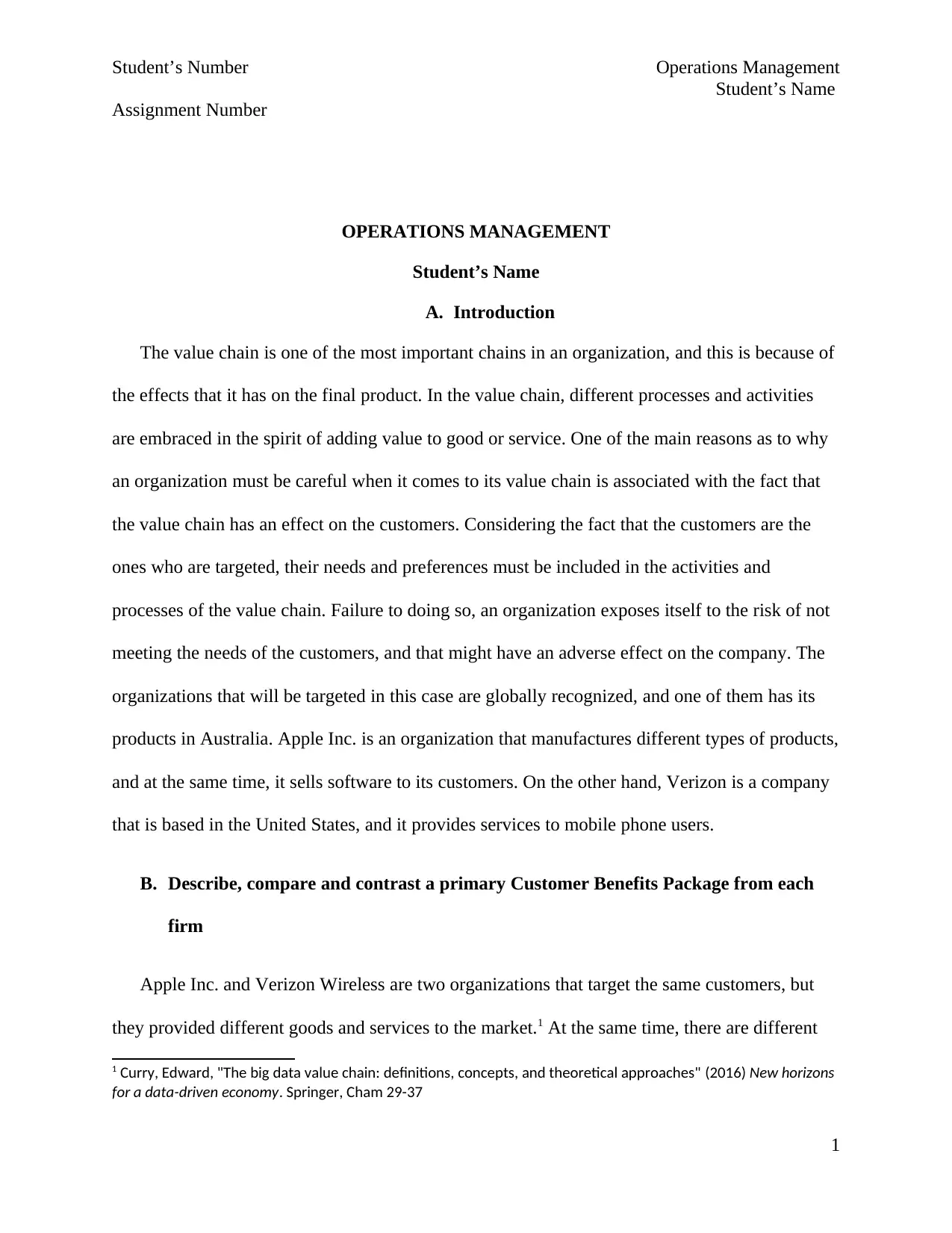
Student’s Number Operations Management
Student’s Name
Assignment Number
OPERATIONS MANAGEMENT
Student’s Name
A. Introduction
The value chain is one of the most important chains in an organization, and this is because of
the effects that it has on the final product. In the value chain, different processes and activities
are embraced in the spirit of adding value to good or service. One of the main reasons as to why
an organization must be careful when it comes to its value chain is associated with the fact that
the value chain has an effect on the customers. Considering the fact that the customers are the
ones who are targeted, their needs and preferences must be included in the activities and
processes of the value chain. Failure to doing so, an organization exposes itself to the risk of not
meeting the needs of the customers, and that might have an adverse effect on the company. The
organizations that will be targeted in this case are globally recognized, and one of them has its
products in Australia. Apple Inc. is an organization that manufactures different types of products,
and at the same time, it sells software to its customers. On the other hand, Verizon is a company
that is based in the United States, and it provides services to mobile phone users.
B. Describe, compare and contrast a primary Customer Benefits Package from each
firm
Apple Inc. and Verizon Wireless are two organizations that target the same customers, but
they provided different goods and services to the market.1 At the same time, there are different
1 Curry, Edward, "The big data value chain: definitions, concepts, and theoretical approaches" (2016) New horizons
for a data-driven economy. Springer, Cham 29-37
1
Student’s Name
Assignment Number
OPERATIONS MANAGEMENT
Student’s Name
A. Introduction
The value chain is one of the most important chains in an organization, and this is because of
the effects that it has on the final product. In the value chain, different processes and activities
are embraced in the spirit of adding value to good or service. One of the main reasons as to why
an organization must be careful when it comes to its value chain is associated with the fact that
the value chain has an effect on the customers. Considering the fact that the customers are the
ones who are targeted, their needs and preferences must be included in the activities and
processes of the value chain. Failure to doing so, an organization exposes itself to the risk of not
meeting the needs of the customers, and that might have an adverse effect on the company. The
organizations that will be targeted in this case are globally recognized, and one of them has its
products in Australia. Apple Inc. is an organization that manufactures different types of products,
and at the same time, it sells software to its customers. On the other hand, Verizon is a company
that is based in the United States, and it provides services to mobile phone users.
B. Describe, compare and contrast a primary Customer Benefits Package from each
firm
Apple Inc. and Verizon Wireless are two organizations that target the same customers, but
they provided different goods and services to the market.1 At the same time, there are different
1 Curry, Edward, "The big data value chain: definitions, concepts, and theoretical approaches" (2016) New horizons
for a data-driven economy. Springer, Cham 29-37
1
Paraphrase This Document
Need a fresh take? Get an instant paraphrase of this document with our AI Paraphraser
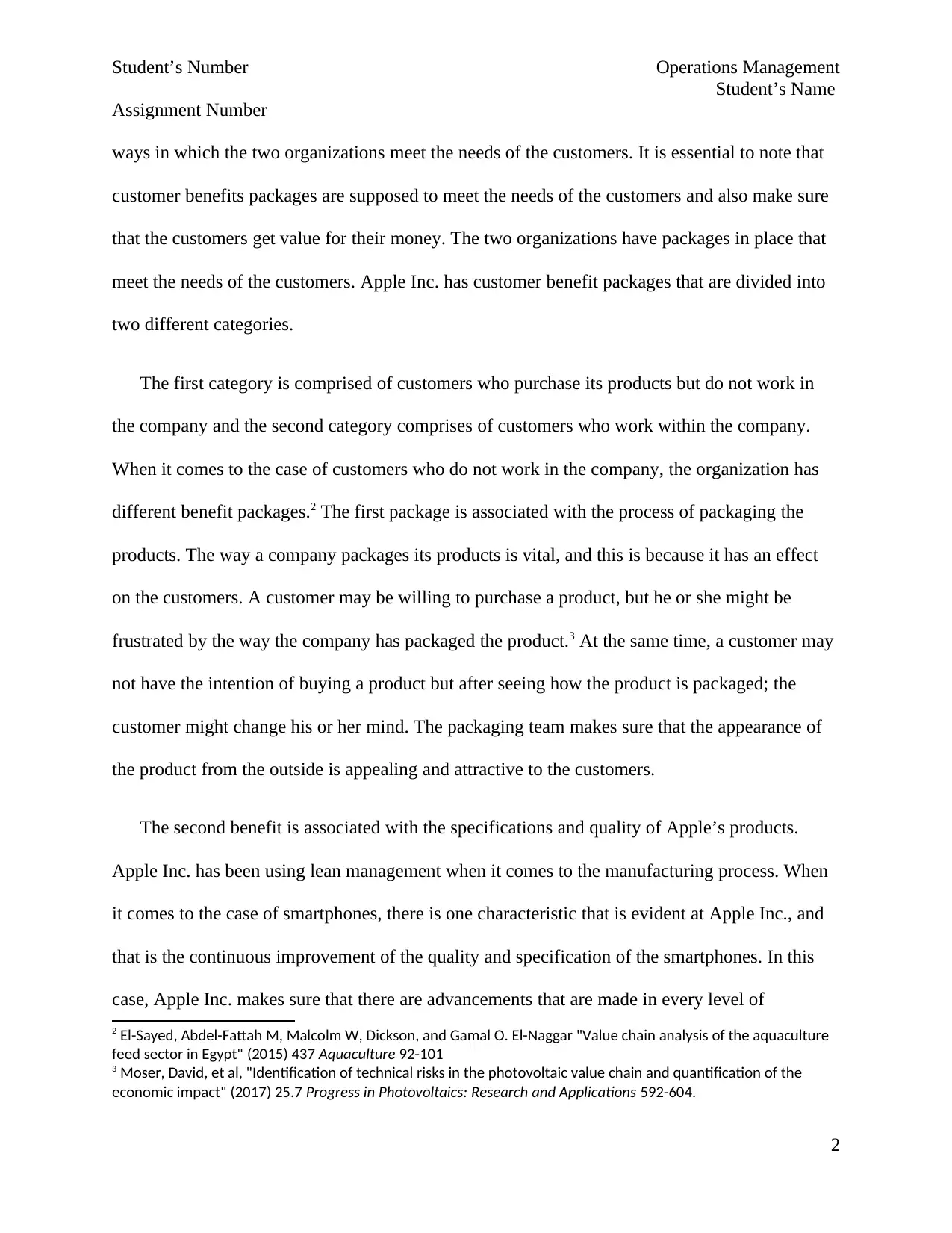
Student’s Number Operations Management
Student’s Name
Assignment Number
ways in which the two organizations meet the needs of the customers. It is essential to note that
customer benefits packages are supposed to meet the needs of the customers and also make sure
that the customers get value for their money. The two organizations have packages in place that
meet the needs of the customers. Apple Inc. has customer benefit packages that are divided into
two different categories.
The first category is comprised of customers who purchase its products but do not work in
the company and the second category comprises of customers who work within the company.
When it comes to the case of customers who do not work in the company, the organization has
different benefit packages.2 The first package is associated with the process of packaging the
products. The way a company packages its products is vital, and this is because it has an effect
on the customers. A customer may be willing to purchase a product, but he or she might be
frustrated by the way the company has packaged the product.3 At the same time, a customer may
not have the intention of buying a product but after seeing how the product is packaged; the
customer might change his or her mind. The packaging team makes sure that the appearance of
the product from the outside is appealing and attractive to the customers.
The second benefit is associated with the specifications and quality of Apple’s products.
Apple Inc. has been using lean management when it comes to the manufacturing process. When
it comes to the case of smartphones, there is one characteristic that is evident at Apple Inc., and
that is the continuous improvement of the quality and specification of the smartphones. In this
case, Apple Inc. makes sure that there are advancements that are made in every level of
2 El-Sayed, Abdel-Fattah M, Malcolm W, Dickson, and Gamal O. El-Naggar "Value chain analysis of the aquaculture
feed sector in Egypt" (2015) 437 Aquaculture 92-101
3 Moser, David, et al, "Identification of technical risks in the photovoltaic value chain and quantification of the
economic impact" (2017) 25.7 Progress in Photovoltaics: Research and Applications 592-604.
2
Student’s Name
Assignment Number
ways in which the two organizations meet the needs of the customers. It is essential to note that
customer benefits packages are supposed to meet the needs of the customers and also make sure
that the customers get value for their money. The two organizations have packages in place that
meet the needs of the customers. Apple Inc. has customer benefit packages that are divided into
two different categories.
The first category is comprised of customers who purchase its products but do not work in
the company and the second category comprises of customers who work within the company.
When it comes to the case of customers who do not work in the company, the organization has
different benefit packages.2 The first package is associated with the process of packaging the
products. The way a company packages its products is vital, and this is because it has an effect
on the customers. A customer may be willing to purchase a product, but he or she might be
frustrated by the way the company has packaged the product.3 At the same time, a customer may
not have the intention of buying a product but after seeing how the product is packaged; the
customer might change his or her mind. The packaging team makes sure that the appearance of
the product from the outside is appealing and attractive to the customers.
The second benefit is associated with the specifications and quality of Apple’s products.
Apple Inc. has been using lean management when it comes to the manufacturing process. When
it comes to the case of smartphones, there is one characteristic that is evident at Apple Inc., and
that is the continuous improvement of the quality and specification of the smartphones. In this
case, Apple Inc. makes sure that there are advancements that are made in every level of
2 El-Sayed, Abdel-Fattah M, Malcolm W, Dickson, and Gamal O. El-Naggar "Value chain analysis of the aquaculture
feed sector in Egypt" (2015) 437 Aquaculture 92-101
3 Moser, David, et al, "Identification of technical risks in the photovoltaic value chain and quantification of the
economic impact" (2017) 25.7 Progress in Photovoltaics: Research and Applications 592-604.
2
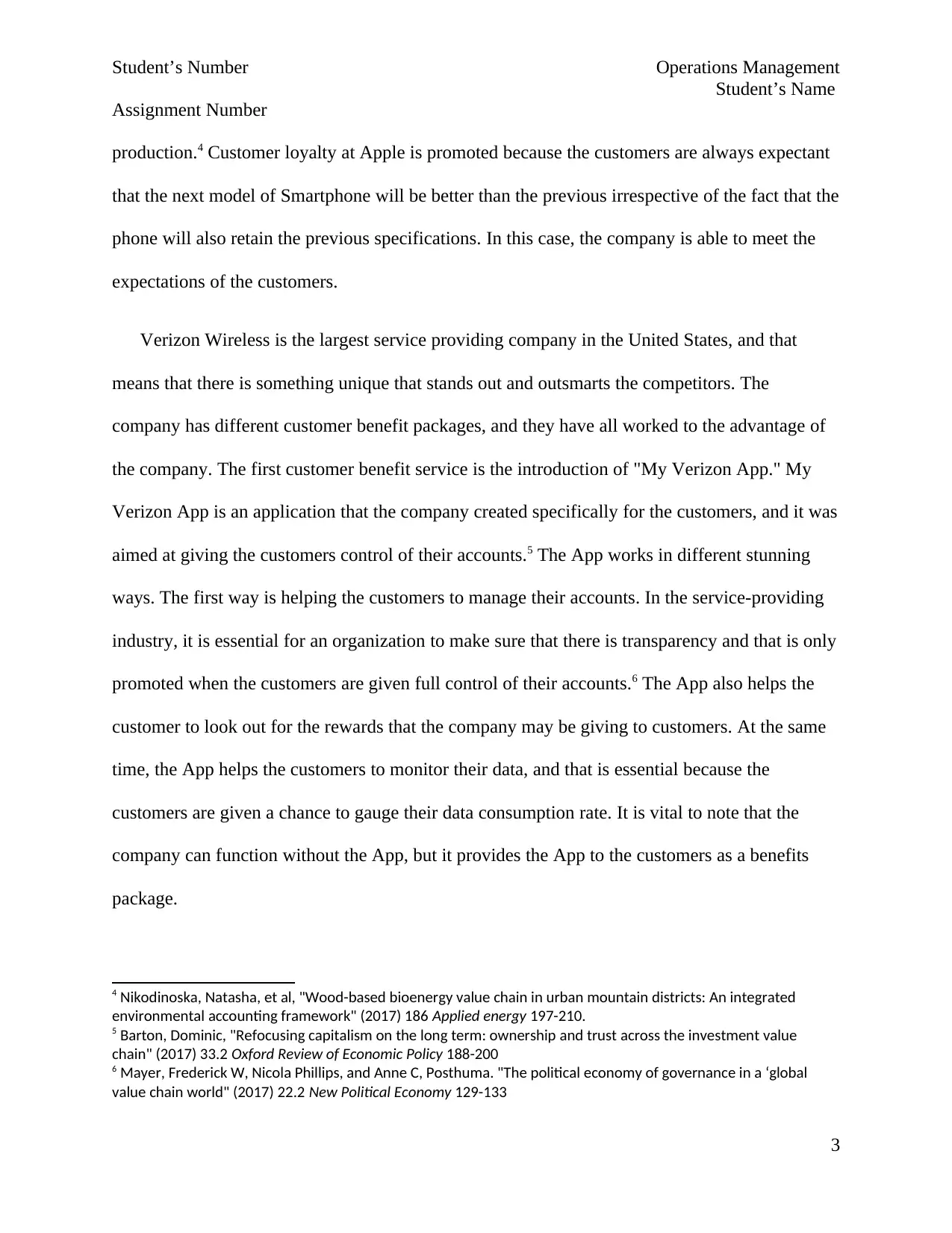
Student’s Number Operations Management
Student’s Name
Assignment Number
production.4 Customer loyalty at Apple is promoted because the customers are always expectant
that the next model of Smartphone will be better than the previous irrespective of the fact that the
phone will also retain the previous specifications. In this case, the company is able to meet the
expectations of the customers.
Verizon Wireless is the largest service providing company in the United States, and that
means that there is something unique that stands out and outsmarts the competitors. The
company has different customer benefit packages, and they have all worked to the advantage of
the company. The first customer benefit service is the introduction of "My Verizon App." My
Verizon App is an application that the company created specifically for the customers, and it was
aimed at giving the customers control of their accounts.5 The App works in different stunning
ways. The first way is helping the customers to manage their accounts. In the service-providing
industry, it is essential for an organization to make sure that there is transparency and that is only
promoted when the customers are given full control of their accounts.6 The App also helps the
customer to look out for the rewards that the company may be giving to customers. At the same
time, the App helps the customers to monitor their data, and that is essential because the
customers are given a chance to gauge their data consumption rate. It is vital to note that the
company can function without the App, but it provides the App to the customers as a benefits
package.
4 Nikodinoska, Natasha, et al, "Wood-based bioenergy value chain in urban mountain districts: An integrated
environmental accounting framework" (2017) 186 Applied energy 197-210.
5 Barton, Dominic, "Refocusing capitalism on the long term: ownership and trust across the investment value
chain" (2017) 33.2 Oxford Review of Economic Policy 188-200
6 Mayer, Frederick W, Nicola Phillips, and Anne C, Posthuma. "The political economy of governance in a ‘global
value chain world" (2017) 22.2 New Political Economy 129-133
3
Student’s Name
Assignment Number
production.4 Customer loyalty at Apple is promoted because the customers are always expectant
that the next model of Smartphone will be better than the previous irrespective of the fact that the
phone will also retain the previous specifications. In this case, the company is able to meet the
expectations of the customers.
Verizon Wireless is the largest service providing company in the United States, and that
means that there is something unique that stands out and outsmarts the competitors. The
company has different customer benefit packages, and they have all worked to the advantage of
the company. The first customer benefit service is the introduction of "My Verizon App." My
Verizon App is an application that the company created specifically for the customers, and it was
aimed at giving the customers control of their accounts.5 The App works in different stunning
ways. The first way is helping the customers to manage their accounts. In the service-providing
industry, it is essential for an organization to make sure that there is transparency and that is only
promoted when the customers are given full control of their accounts.6 The App also helps the
customer to look out for the rewards that the company may be giving to customers. At the same
time, the App helps the customers to monitor their data, and that is essential because the
customers are given a chance to gauge their data consumption rate. It is vital to note that the
company can function without the App, but it provides the App to the customers as a benefits
package.
4 Nikodinoska, Natasha, et al, "Wood-based bioenergy value chain in urban mountain districts: An integrated
environmental accounting framework" (2017) 186 Applied energy 197-210.
5 Barton, Dominic, "Refocusing capitalism on the long term: ownership and trust across the investment value
chain" (2017) 33.2 Oxford Review of Economic Policy 188-200
6 Mayer, Frederick W, Nicola Phillips, and Anne C, Posthuma. "The political economy of governance in a ‘global
value chain world" (2017) 22.2 New Political Economy 129-133
3
⊘ This is a preview!⊘
Do you want full access?
Subscribe today to unlock all pages.

Trusted by 1+ million students worldwide
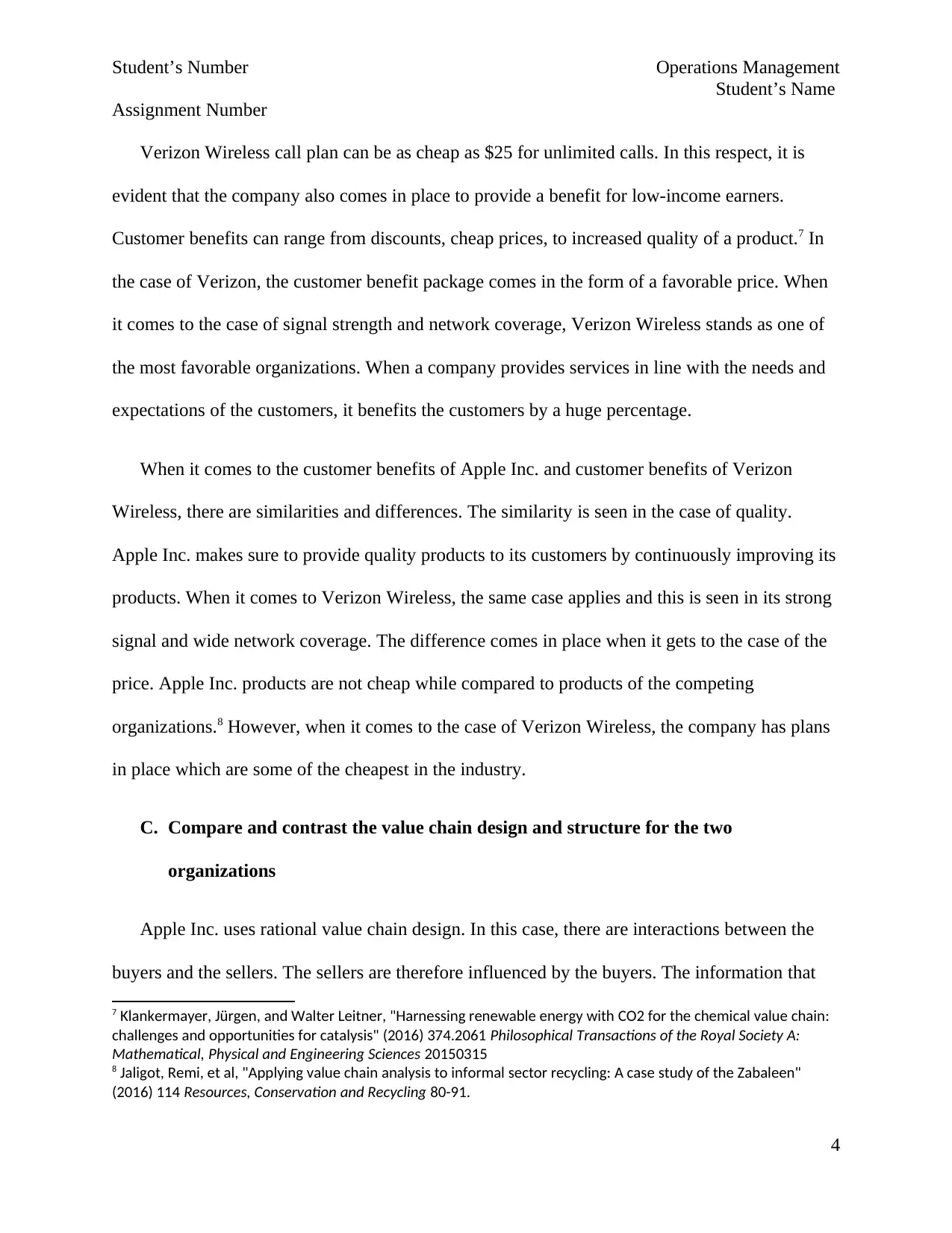
Student’s Number Operations Management
Student’s Name
Assignment Number
Verizon Wireless call plan can be as cheap as $25 for unlimited calls. In this respect, it is
evident that the company also comes in place to provide a benefit for low-income earners.
Customer benefits can range from discounts, cheap prices, to increased quality of a product.7 In
the case of Verizon, the customer benefit package comes in the form of a favorable price. When
it comes to the case of signal strength and network coverage, Verizon Wireless stands as one of
the most favorable organizations. When a company provides services in line with the needs and
expectations of the customers, it benefits the customers by a huge percentage.
When it comes to the customer benefits of Apple Inc. and customer benefits of Verizon
Wireless, there are similarities and differences. The similarity is seen in the case of quality.
Apple Inc. makes sure to provide quality products to its customers by continuously improving its
products. When it comes to Verizon Wireless, the same case applies and this is seen in its strong
signal and wide network coverage. The difference comes in place when it gets to the case of the
price. Apple Inc. products are not cheap while compared to products of the competing
organizations.8 However, when it comes to the case of Verizon Wireless, the company has plans
in place which are some of the cheapest in the industry.
C. Compare and contrast the value chain design and structure for the two
organizations
Apple Inc. uses rational value chain design. In this case, there are interactions between the
buyers and the sellers. The sellers are therefore influenced by the buyers. The information that
7 Klankermayer, Jürgen, and Walter Leitner, "Harnessing renewable energy with CO2 for the chemical value chain:
challenges and opportunities for catalysis" (2016) 374.2061 Philosophical Transactions of the Royal Society A:
Mathematical, Physical and Engineering Sciences 20150315
8 Jaligot, Remi, et al, "Applying value chain analysis to informal sector recycling: A case study of the Zabaleen"
(2016) 114 Resources, Conservation and Recycling 80-91.
4
Student’s Name
Assignment Number
Verizon Wireless call plan can be as cheap as $25 for unlimited calls. In this respect, it is
evident that the company also comes in place to provide a benefit for low-income earners.
Customer benefits can range from discounts, cheap prices, to increased quality of a product.7 In
the case of Verizon, the customer benefit package comes in the form of a favorable price. When
it comes to the case of signal strength and network coverage, Verizon Wireless stands as one of
the most favorable organizations. When a company provides services in line with the needs and
expectations of the customers, it benefits the customers by a huge percentage.
When it comes to the customer benefits of Apple Inc. and customer benefits of Verizon
Wireless, there are similarities and differences. The similarity is seen in the case of quality.
Apple Inc. makes sure to provide quality products to its customers by continuously improving its
products. When it comes to Verizon Wireless, the same case applies and this is seen in its strong
signal and wide network coverage. The difference comes in place when it gets to the case of the
price. Apple Inc. products are not cheap while compared to products of the competing
organizations.8 However, when it comes to the case of Verizon Wireless, the company has plans
in place which are some of the cheapest in the industry.
C. Compare and contrast the value chain design and structure for the two
organizations
Apple Inc. uses rational value chain design. In this case, there are interactions between the
buyers and the sellers. The sellers are therefore influenced by the buyers. The information that
7 Klankermayer, Jürgen, and Walter Leitner, "Harnessing renewable energy with CO2 for the chemical value chain:
challenges and opportunities for catalysis" (2016) 374.2061 Philosophical Transactions of the Royal Society A:
Mathematical, Physical and Engineering Sciences 20150315
8 Jaligot, Remi, et al, "Applying value chain analysis to informal sector recycling: A case study of the Zabaleen"
(2016) 114 Resources, Conservation and Recycling 80-91.
4
Paraphrase This Document
Need a fresh take? Get an instant paraphrase of this document with our AI Paraphraser
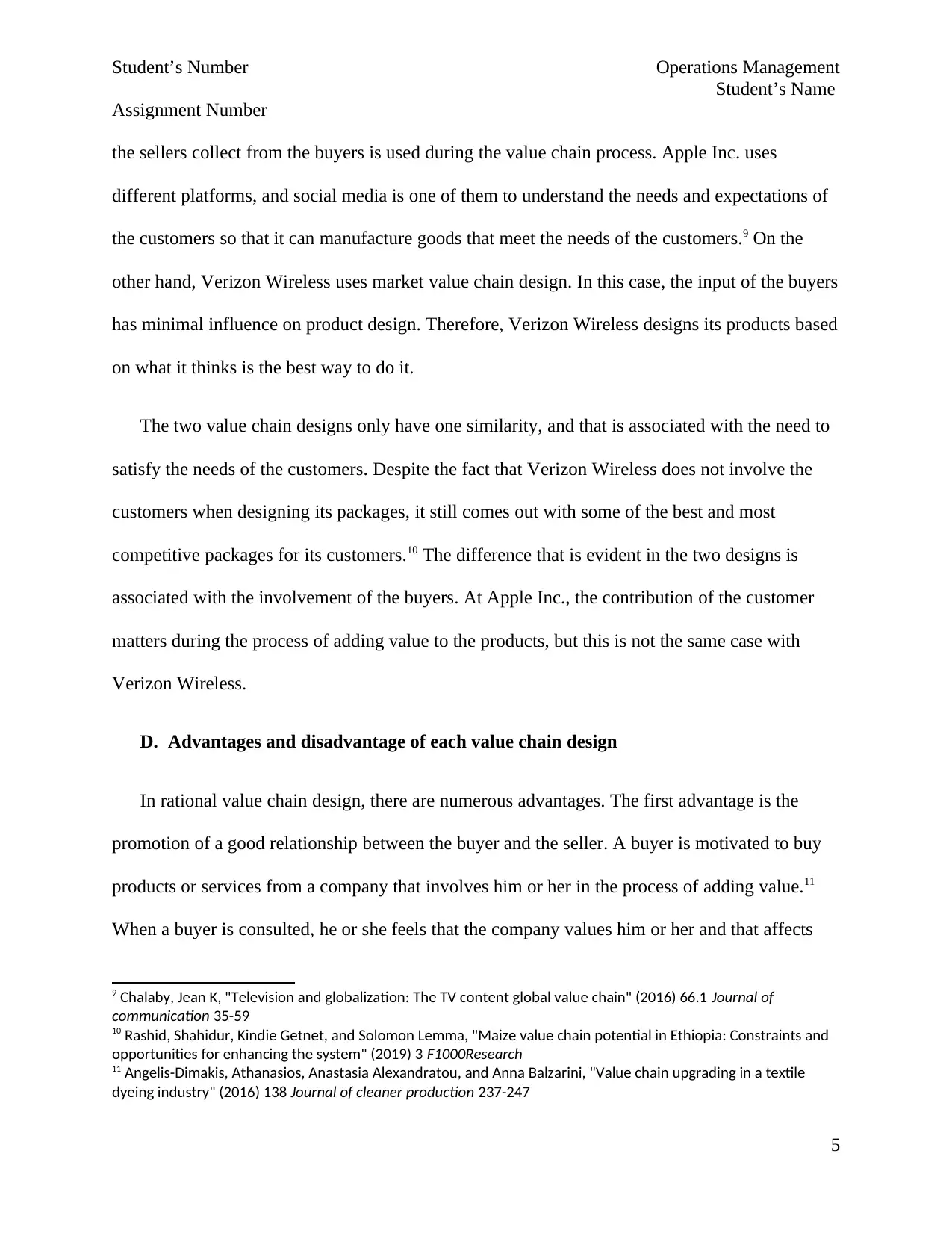
Student’s Number Operations Management
Student’s Name
Assignment Number
the sellers collect from the buyers is used during the value chain process. Apple Inc. uses
different platforms, and social media is one of them to understand the needs and expectations of
the customers so that it can manufacture goods that meet the needs of the customers.9 On the
other hand, Verizon Wireless uses market value chain design. In this case, the input of the buyers
has minimal influence on product design. Therefore, Verizon Wireless designs its products based
on what it thinks is the best way to do it.
The two value chain designs only have one similarity, and that is associated with the need to
satisfy the needs of the customers. Despite the fact that Verizon Wireless does not involve the
customers when designing its packages, it still comes out with some of the best and most
competitive packages for its customers.10 The difference that is evident in the two designs is
associated with the involvement of the buyers. At Apple Inc., the contribution of the customer
matters during the process of adding value to the products, but this is not the same case with
Verizon Wireless.
D. Advantages and disadvantage of each value chain design
In rational value chain design, there are numerous advantages. The first advantage is the
promotion of a good relationship between the buyer and the seller. A buyer is motivated to buy
products or services from a company that involves him or her in the process of adding value.11
When a buyer is consulted, he or she feels that the company values him or her and that affects
9 Chalaby, Jean K, "Television and globalization: The TV content global value chain" (2016) 66.1 Journal of
communication 35-59
10 Rashid, Shahidur, Kindie Getnet, and Solomon Lemma, "Maize value chain potential in Ethiopia: Constraints and
opportunities for enhancing the system" (2019) 3 F1000Research
11 Angelis-Dimakis, Athanasios, Anastasia Alexandratou, and Anna Balzarini, "Value chain upgrading in a textile
dyeing industry" (2016) 138 Journal of cleaner production 237-247
5
Student’s Name
Assignment Number
the sellers collect from the buyers is used during the value chain process. Apple Inc. uses
different platforms, and social media is one of them to understand the needs and expectations of
the customers so that it can manufacture goods that meet the needs of the customers.9 On the
other hand, Verizon Wireless uses market value chain design. In this case, the input of the buyers
has minimal influence on product design. Therefore, Verizon Wireless designs its products based
on what it thinks is the best way to do it.
The two value chain designs only have one similarity, and that is associated with the need to
satisfy the needs of the customers. Despite the fact that Verizon Wireless does not involve the
customers when designing its packages, it still comes out with some of the best and most
competitive packages for its customers.10 The difference that is evident in the two designs is
associated with the involvement of the buyers. At Apple Inc., the contribution of the customer
matters during the process of adding value to the products, but this is not the same case with
Verizon Wireless.
D. Advantages and disadvantage of each value chain design
In rational value chain design, there are numerous advantages. The first advantage is the
promotion of a good relationship between the buyer and the seller. A buyer is motivated to buy
products or services from a company that involves him or her in the process of adding value.11
When a buyer is consulted, he or she feels that the company values him or her and that affects
9 Chalaby, Jean K, "Television and globalization: The TV content global value chain" (2016) 66.1 Journal of
communication 35-59
10 Rashid, Shahidur, Kindie Getnet, and Solomon Lemma, "Maize value chain potential in Ethiopia: Constraints and
opportunities for enhancing the system" (2019) 3 F1000Research
11 Angelis-Dimakis, Athanasios, Anastasia Alexandratou, and Anna Balzarini, "Value chain upgrading in a textile
dyeing industry" (2016) 138 Journal of cleaner production 237-247
5
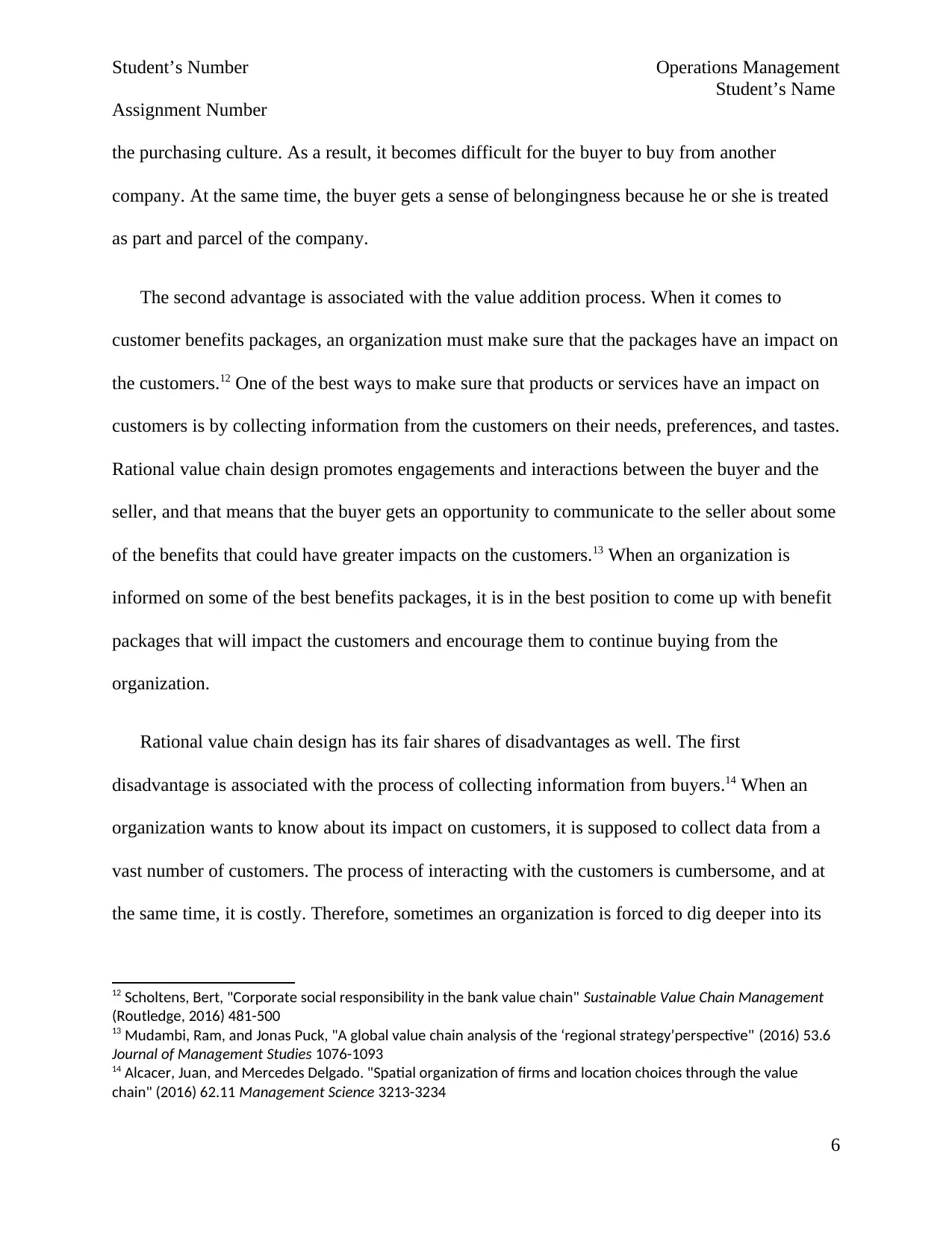
Student’s Number Operations Management
Student’s Name
Assignment Number
the purchasing culture. As a result, it becomes difficult for the buyer to buy from another
company. At the same time, the buyer gets a sense of belongingness because he or she is treated
as part and parcel of the company.
The second advantage is associated with the value addition process. When it comes to
customer benefits packages, an organization must make sure that the packages have an impact on
the customers.12 One of the best ways to make sure that products or services have an impact on
customers is by collecting information from the customers on their needs, preferences, and tastes.
Rational value chain design promotes engagements and interactions between the buyer and the
seller, and that means that the buyer gets an opportunity to communicate to the seller about some
of the benefits that could have greater impacts on the customers.13 When an organization is
informed on some of the best benefits packages, it is in the best position to come up with benefit
packages that will impact the customers and encourage them to continue buying from the
organization.
Rational value chain design has its fair shares of disadvantages as well. The first
disadvantage is associated with the process of collecting information from buyers.14 When an
organization wants to know about its impact on customers, it is supposed to collect data from a
vast number of customers. The process of interacting with the customers is cumbersome, and at
the same time, it is costly. Therefore, sometimes an organization is forced to dig deeper into its
12 Scholtens, Bert, "Corporate social responsibility in the bank value chain" Sustainable Value Chain Management
(Routledge, 2016) 481-500
13 Mudambi, Ram, and Jonas Puck, "A global value chain analysis of the ‘regional strategy’perspective" (2016) 53.6
Journal of Management Studies 1076-1093
14 Alcacer, Juan, and Mercedes Delgado. "Spatial organization of firms and location choices through the value
chain" (2016) 62.11 Management Science 3213-3234
6
Student’s Name
Assignment Number
the purchasing culture. As a result, it becomes difficult for the buyer to buy from another
company. At the same time, the buyer gets a sense of belongingness because he or she is treated
as part and parcel of the company.
The second advantage is associated with the value addition process. When it comes to
customer benefits packages, an organization must make sure that the packages have an impact on
the customers.12 One of the best ways to make sure that products or services have an impact on
customers is by collecting information from the customers on their needs, preferences, and tastes.
Rational value chain design promotes engagements and interactions between the buyer and the
seller, and that means that the buyer gets an opportunity to communicate to the seller about some
of the benefits that could have greater impacts on the customers.13 When an organization is
informed on some of the best benefits packages, it is in the best position to come up with benefit
packages that will impact the customers and encourage them to continue buying from the
organization.
Rational value chain design has its fair shares of disadvantages as well. The first
disadvantage is associated with the process of collecting information from buyers.14 When an
organization wants to know about its impact on customers, it is supposed to collect data from a
vast number of customers. The process of interacting with the customers is cumbersome, and at
the same time, it is costly. Therefore, sometimes an organization is forced to dig deeper into its
12 Scholtens, Bert, "Corporate social responsibility in the bank value chain" Sustainable Value Chain Management
(Routledge, 2016) 481-500
13 Mudambi, Ram, and Jonas Puck, "A global value chain analysis of the ‘regional strategy’perspective" (2016) 53.6
Journal of Management Studies 1076-1093
14 Alcacer, Juan, and Mercedes Delgado. "Spatial organization of firms and location choices through the value
chain" (2016) 62.11 Management Science 3213-3234
6
⊘ This is a preview!⊘
Do you want full access?
Subscribe today to unlock all pages.

Trusted by 1+ million students worldwide
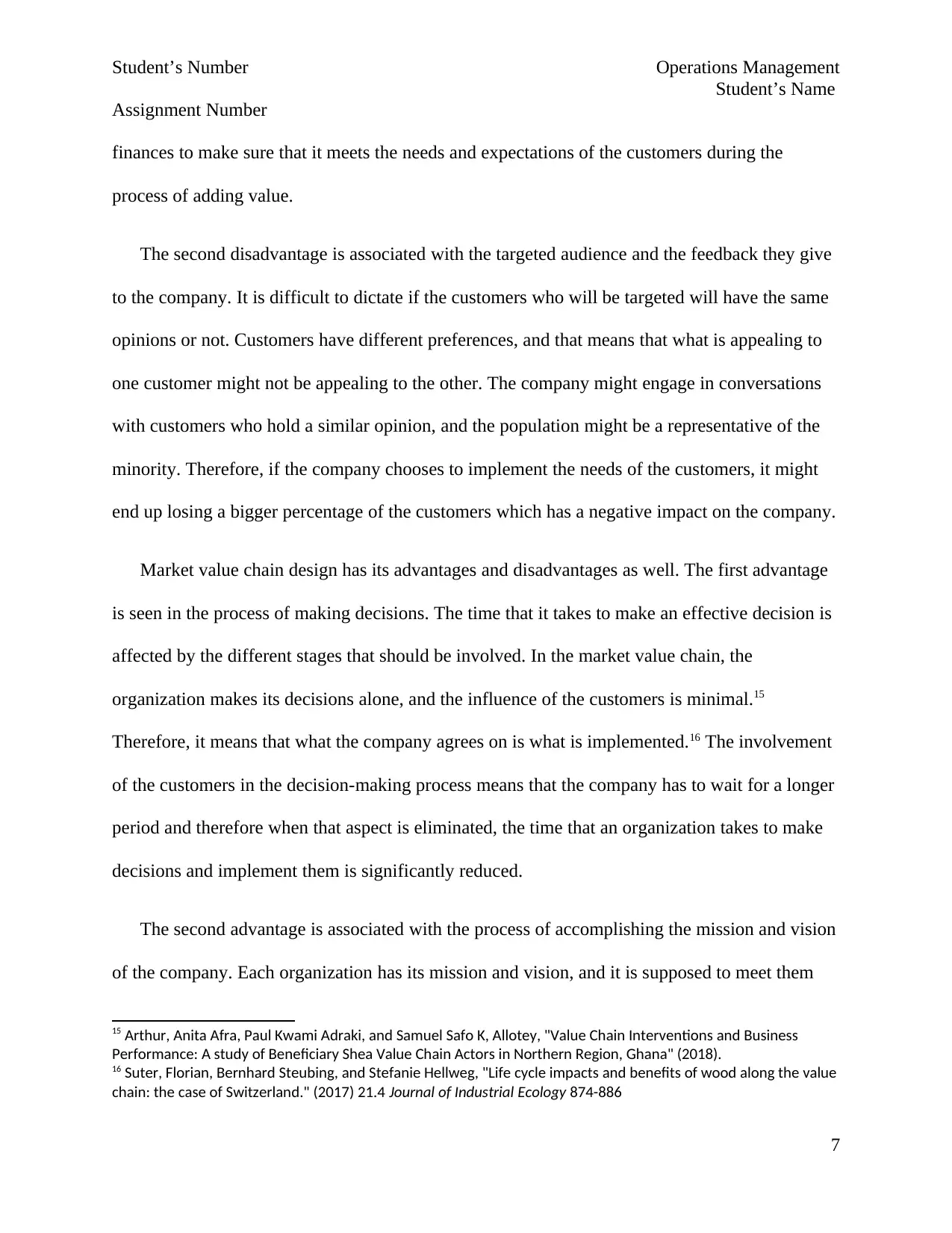
Student’s Number Operations Management
Student’s Name
Assignment Number
finances to make sure that it meets the needs and expectations of the customers during the
process of adding value.
The second disadvantage is associated with the targeted audience and the feedback they give
to the company. It is difficult to dictate if the customers who will be targeted will have the same
opinions or not. Customers have different preferences, and that means that what is appealing to
one customer might not be appealing to the other. The company might engage in conversations
with customers who hold a similar opinion, and the population might be a representative of the
minority. Therefore, if the company chooses to implement the needs of the customers, it might
end up losing a bigger percentage of the customers which has a negative impact on the company.
Market value chain design has its advantages and disadvantages as well. The first advantage
is seen in the process of making decisions. The time that it takes to make an effective decision is
affected by the different stages that should be involved. In the market value chain, the
organization makes its decisions alone, and the influence of the customers is minimal.15
Therefore, it means that what the company agrees on is what is implemented.16 The involvement
of the customers in the decision-making process means that the company has to wait for a longer
period and therefore when that aspect is eliminated, the time that an organization takes to make
decisions and implement them is significantly reduced.
The second advantage is associated with the process of accomplishing the mission and vision
of the company. Each organization has its mission and vision, and it is supposed to meet them
15 Arthur, Anita Afra, Paul Kwami Adraki, and Samuel Safo K, Allotey, "Value Chain Interventions and Business
Performance: A study of Beneficiary Shea Value Chain Actors in Northern Region, Ghana" (2018).
16 Suter, Florian, Bernhard Steubing, and Stefanie Hellweg, "Life cycle impacts and benefits of wood along the value
chain: the case of Switzerland." (2017) 21.4 Journal of Industrial Ecology 874-886
7
Student’s Name
Assignment Number
finances to make sure that it meets the needs and expectations of the customers during the
process of adding value.
The second disadvantage is associated with the targeted audience and the feedback they give
to the company. It is difficult to dictate if the customers who will be targeted will have the same
opinions or not. Customers have different preferences, and that means that what is appealing to
one customer might not be appealing to the other. The company might engage in conversations
with customers who hold a similar opinion, and the population might be a representative of the
minority. Therefore, if the company chooses to implement the needs of the customers, it might
end up losing a bigger percentage of the customers which has a negative impact on the company.
Market value chain design has its advantages and disadvantages as well. The first advantage
is seen in the process of making decisions. The time that it takes to make an effective decision is
affected by the different stages that should be involved. In the market value chain, the
organization makes its decisions alone, and the influence of the customers is minimal.15
Therefore, it means that what the company agrees on is what is implemented.16 The involvement
of the customers in the decision-making process means that the company has to wait for a longer
period and therefore when that aspect is eliminated, the time that an organization takes to make
decisions and implement them is significantly reduced.
The second advantage is associated with the process of accomplishing the mission and vision
of the company. Each organization has its mission and vision, and it is supposed to meet them
15 Arthur, Anita Afra, Paul Kwami Adraki, and Samuel Safo K, Allotey, "Value Chain Interventions and Business
Performance: A study of Beneficiary Shea Value Chain Actors in Northern Region, Ghana" (2018).
16 Suter, Florian, Bernhard Steubing, and Stefanie Hellweg, "Life cycle impacts and benefits of wood along the value
chain: the case of Switzerland." (2017) 21.4 Journal of Industrial Ecology 874-886
7
Paraphrase This Document
Need a fresh take? Get an instant paraphrase of this document with our AI Paraphraser
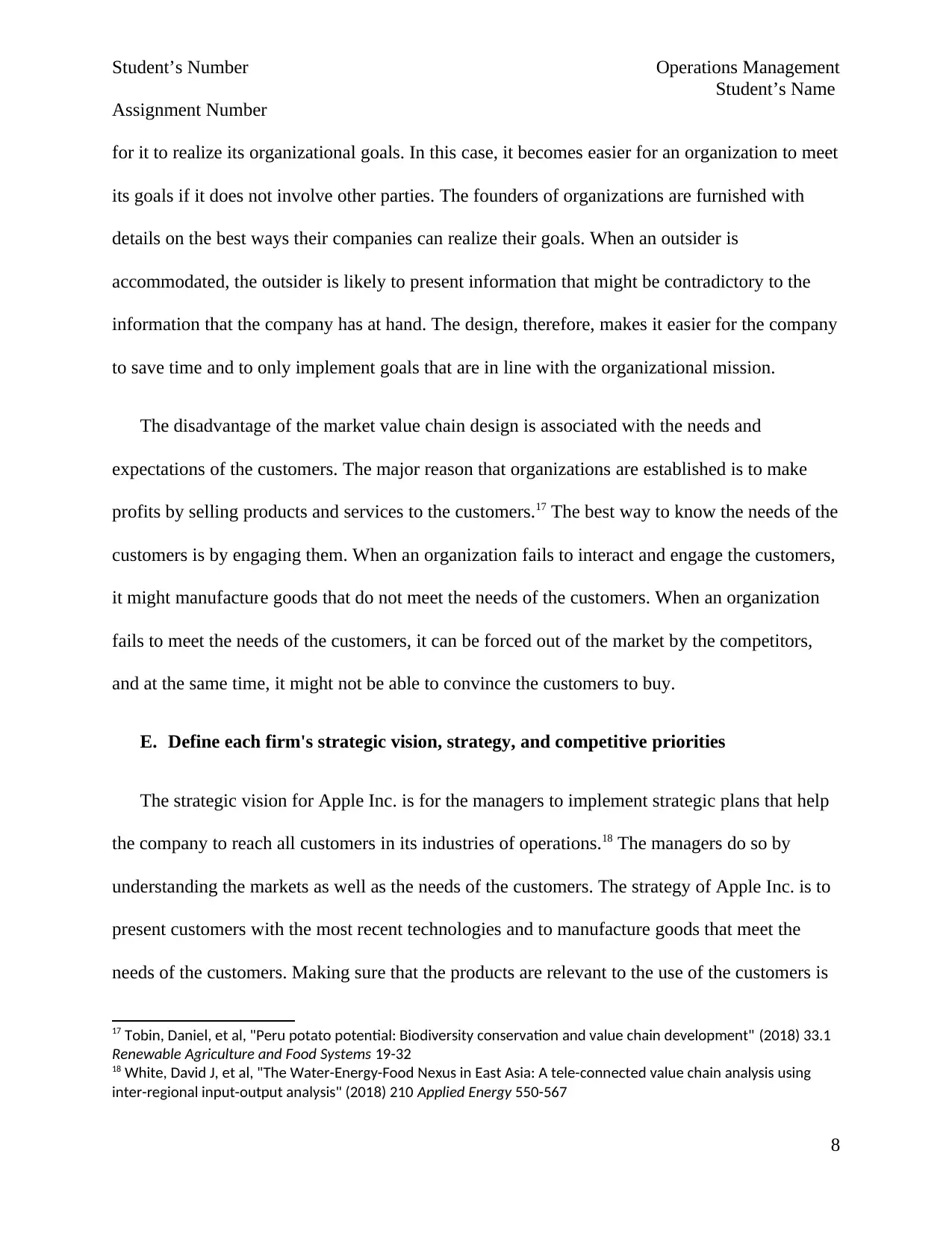
Student’s Number Operations Management
Student’s Name
Assignment Number
for it to realize its organizational goals. In this case, it becomes easier for an organization to meet
its goals if it does not involve other parties. The founders of organizations are furnished with
details on the best ways their companies can realize their goals. When an outsider is
accommodated, the outsider is likely to present information that might be contradictory to the
information that the company has at hand. The design, therefore, makes it easier for the company
to save time and to only implement goals that are in line with the organizational mission.
The disadvantage of the market value chain design is associated with the needs and
expectations of the customers. The major reason that organizations are established is to make
profits by selling products and services to the customers.17 The best way to know the needs of the
customers is by engaging them. When an organization fails to interact and engage the customers,
it might manufacture goods that do not meet the needs of the customers. When an organization
fails to meet the needs of the customers, it can be forced out of the market by the competitors,
and at the same time, it might not be able to convince the customers to buy.
E. Define each firm's strategic vision, strategy, and competitive priorities
The strategic vision for Apple Inc. is for the managers to implement strategic plans that help
the company to reach all customers in its industries of operations.18 The managers do so by
understanding the markets as well as the needs of the customers. The strategy of Apple Inc. is to
present customers with the most recent technologies and to manufacture goods that meet the
needs of the customers. Making sure that the products are relevant to the use of the customers is
17 Tobin, Daniel, et al, "Peru potato potential: Biodiversity conservation and value chain development" (2018) 33.1
Renewable Agriculture and Food Systems 19-32
18 White, David J, et al, "The Water-Energy-Food Nexus in East Asia: A tele-connected value chain analysis using
inter-regional input-output analysis" (2018) 210 Applied Energy 550-567
8
Student’s Name
Assignment Number
for it to realize its organizational goals. In this case, it becomes easier for an organization to meet
its goals if it does not involve other parties. The founders of organizations are furnished with
details on the best ways their companies can realize their goals. When an outsider is
accommodated, the outsider is likely to present information that might be contradictory to the
information that the company has at hand. The design, therefore, makes it easier for the company
to save time and to only implement goals that are in line with the organizational mission.
The disadvantage of the market value chain design is associated with the needs and
expectations of the customers. The major reason that organizations are established is to make
profits by selling products and services to the customers.17 The best way to know the needs of the
customers is by engaging them. When an organization fails to interact and engage the customers,
it might manufacture goods that do not meet the needs of the customers. When an organization
fails to meet the needs of the customers, it can be forced out of the market by the competitors,
and at the same time, it might not be able to convince the customers to buy.
E. Define each firm's strategic vision, strategy, and competitive priorities
The strategic vision for Apple Inc. is for the managers to implement strategic plans that help
the company to reach all customers in its industries of operations.18 The managers do so by
understanding the markets as well as the needs of the customers. The strategy of Apple Inc. is to
present customers with the most recent technologies and to manufacture goods that meet the
needs of the customers. Making sure that the products are relevant to the use of the customers is
17 Tobin, Daniel, et al, "Peru potato potential: Biodiversity conservation and value chain development" (2018) 33.1
Renewable Agriculture and Food Systems 19-32
18 White, David J, et al, "The Water-Energy-Food Nexus in East Asia: A tele-connected value chain analysis using
inter-regional input-output analysis" (2018) 210 Applied Energy 550-567
8
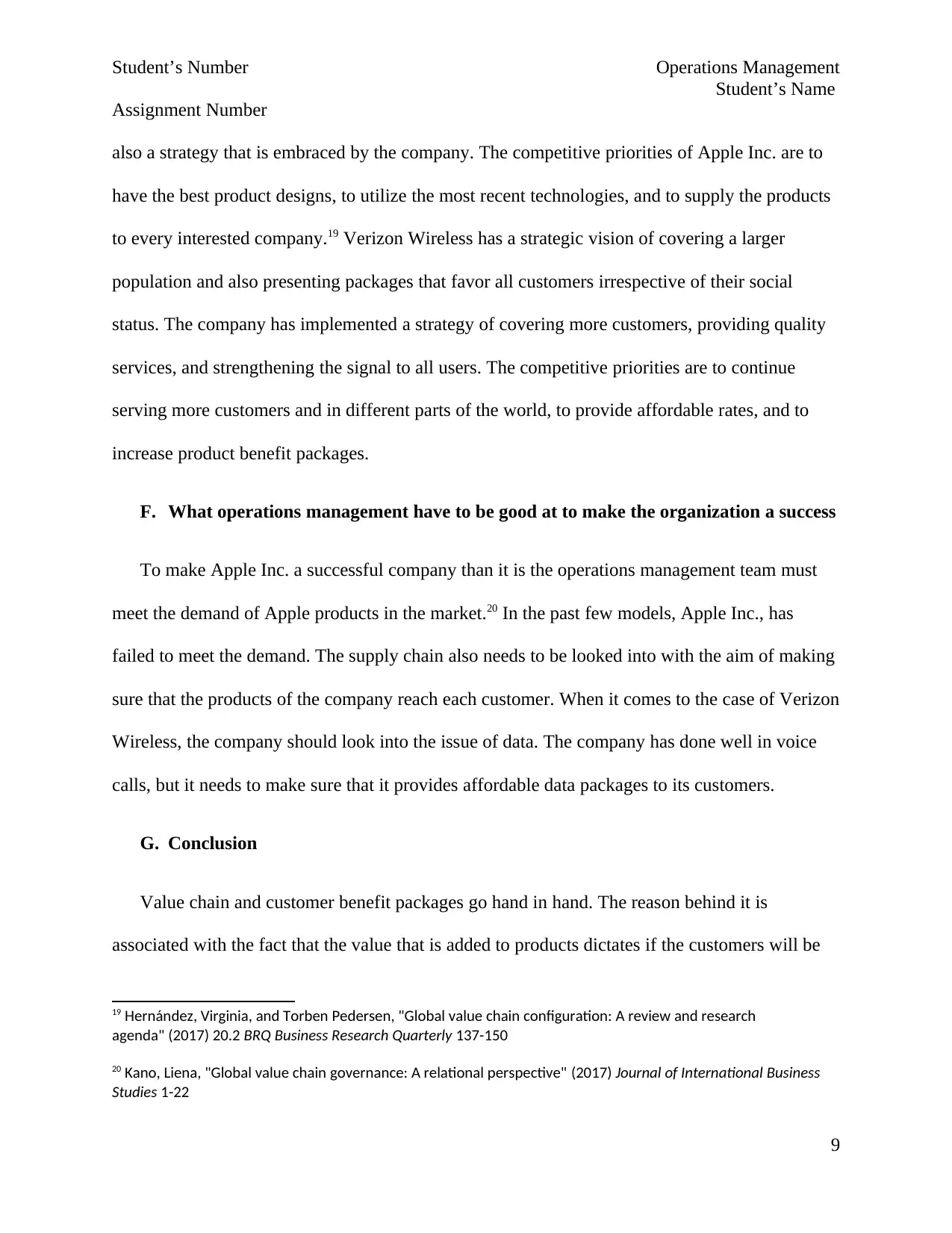
Student’s Number Operations Management
Student’s Name
Assignment Number
also a strategy that is embraced by the company. The competitive priorities of Apple Inc. are to
have the best product designs, to utilize the most recent technologies, and to supply the products
to every interested company.19 Verizon Wireless has a strategic vision of covering a larger
population and also presenting packages that favor all customers irrespective of their social
status. The company has implemented a strategy of covering more customers, providing quality
services, and strengthening the signal to all users. The competitive priorities are to continue
serving more customers and in different parts of the world, to provide affordable rates, and to
increase product benefit packages.
F. What operations management have to be good at to make the organization a success
To make Apple Inc. a successful company than it is the operations management team must
meet the demand of Apple products in the market.20 In the past few models, Apple Inc., has
failed to meet the demand. The supply chain also needs to be looked into with the aim of making
sure that the products of the company reach each customer. When it comes to the case of Verizon
Wireless, the company should look into the issue of data. The company has done well in voice
calls, but it needs to make sure that it provides affordable data packages to its customers.
G. Conclusion
Value chain and customer benefit packages go hand in hand. The reason behind it is
associated with the fact that the value that is added to products dictates if the customers will be
19 Hernández, Virginia, and Torben Pedersen, "Global value chain configuration: A review and research
agenda" (2017) 20.2 BRQ Business Research Quarterly 137-150
20 Kano, Liena, "Global value chain governance: A relational perspective" (2017) Journal of International Business
Studies 1-22
9
Student’s Name
Assignment Number
also a strategy that is embraced by the company. The competitive priorities of Apple Inc. are to
have the best product designs, to utilize the most recent technologies, and to supply the products
to every interested company.19 Verizon Wireless has a strategic vision of covering a larger
population and also presenting packages that favor all customers irrespective of their social
status. The company has implemented a strategy of covering more customers, providing quality
services, and strengthening the signal to all users. The competitive priorities are to continue
serving more customers and in different parts of the world, to provide affordable rates, and to
increase product benefit packages.
F. What operations management have to be good at to make the organization a success
To make Apple Inc. a successful company than it is the operations management team must
meet the demand of Apple products in the market.20 In the past few models, Apple Inc., has
failed to meet the demand. The supply chain also needs to be looked into with the aim of making
sure that the products of the company reach each customer. When it comes to the case of Verizon
Wireless, the company should look into the issue of data. The company has done well in voice
calls, but it needs to make sure that it provides affordable data packages to its customers.
G. Conclusion
Value chain and customer benefit packages go hand in hand. The reason behind it is
associated with the fact that the value that is added to products dictates if the customers will be
19 Hernández, Virginia, and Torben Pedersen, "Global value chain configuration: A review and research
agenda" (2017) 20.2 BRQ Business Research Quarterly 137-150
20 Kano, Liena, "Global value chain governance: A relational perspective" (2017) Journal of International Business
Studies 1-22
9
⊘ This is a preview!⊘
Do you want full access?
Subscribe today to unlock all pages.

Trusted by 1+ million students worldwide
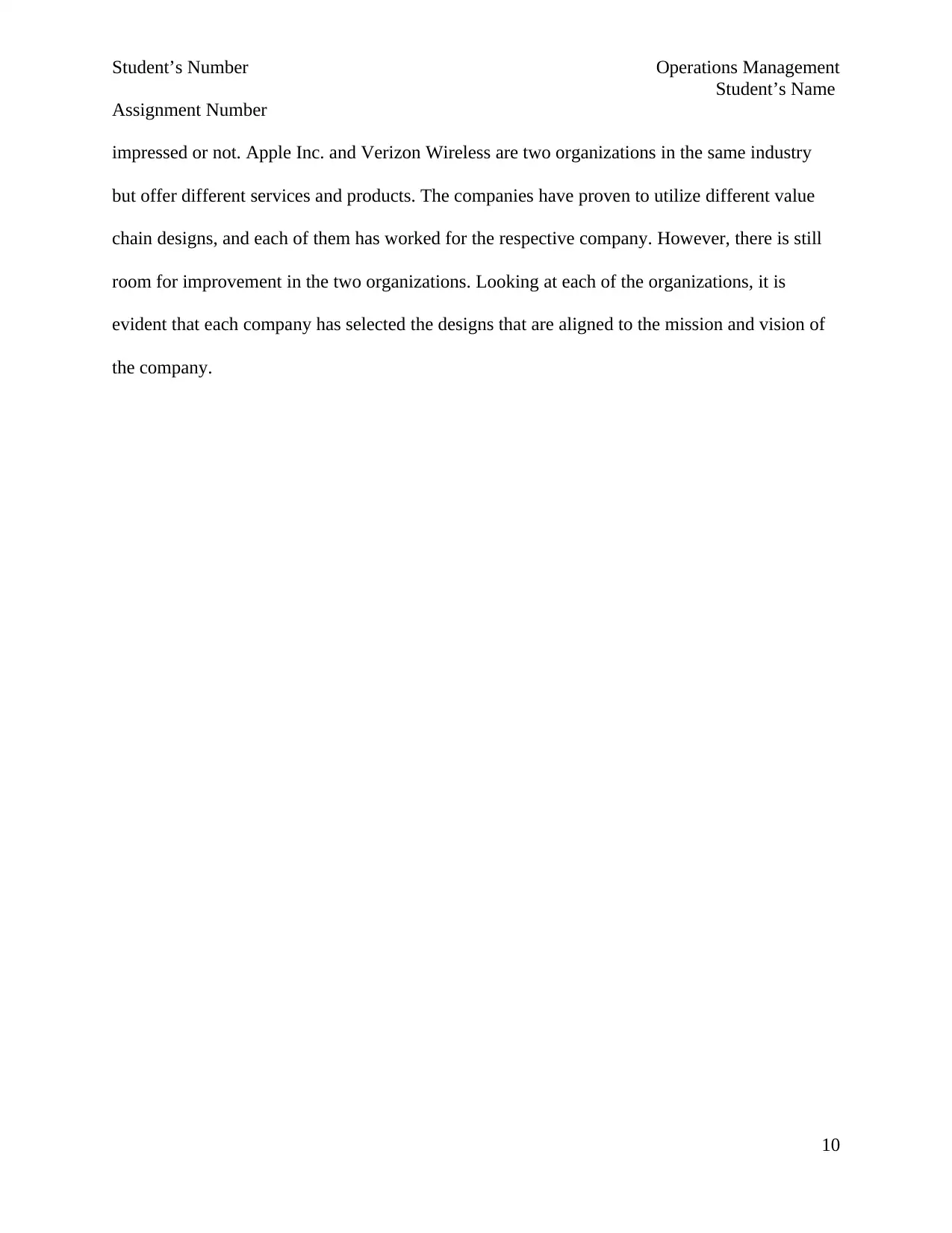
Student’s Number Operations Management
Student’s Name
Assignment Number
impressed or not. Apple Inc. and Verizon Wireless are two organizations in the same industry
but offer different services and products. The companies have proven to utilize different value
chain designs, and each of them has worked for the respective company. However, there is still
room for improvement in the two organizations. Looking at each of the organizations, it is
evident that each company has selected the designs that are aligned to the mission and vision of
the company.
10
Student’s Name
Assignment Number
impressed or not. Apple Inc. and Verizon Wireless are two organizations in the same industry
but offer different services and products. The companies have proven to utilize different value
chain designs, and each of them has worked for the respective company. However, there is still
room for improvement in the two organizations. Looking at each of the organizations, it is
evident that each company has selected the designs that are aligned to the mission and vision of
the company.
10
Paraphrase This Document
Need a fresh take? Get an instant paraphrase of this document with our AI Paraphraser
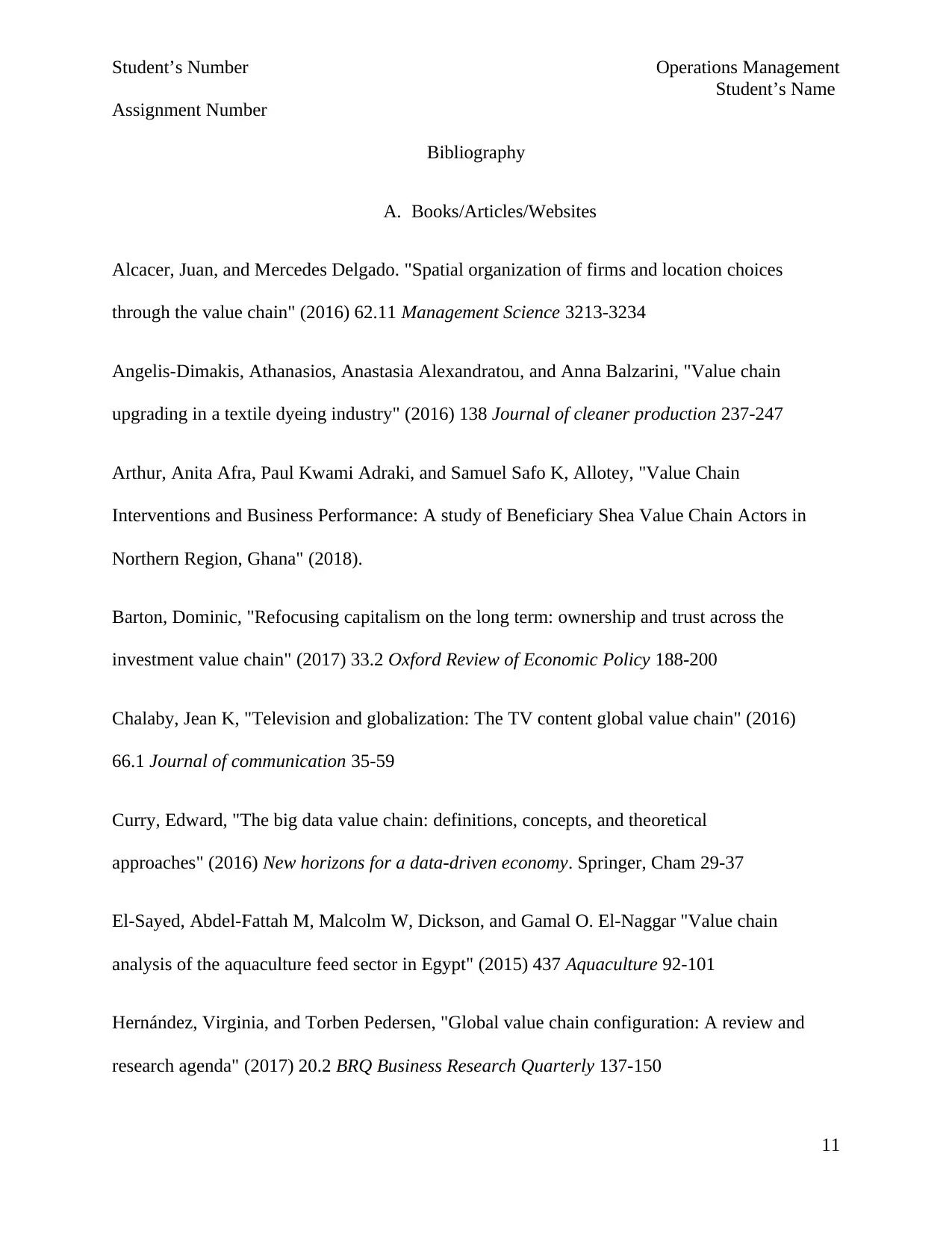
Student’s Number Operations Management
Student’s Name
Assignment Number
Bibliography
A. Books/Articles/Websites
Alcacer, Juan, and Mercedes Delgado. "Spatial organization of firms and location choices
through the value chain" (2016) 62.11 Management Science 3213-3234
Angelis-Dimakis, Athanasios, Anastasia Alexandratou, and Anna Balzarini, "Value chain
upgrading in a textile dyeing industry" (2016) 138 Journal of cleaner production 237-247
Arthur, Anita Afra, Paul Kwami Adraki, and Samuel Safo K, Allotey, "Value Chain
Interventions and Business Performance: A study of Beneficiary Shea Value Chain Actors in
Northern Region, Ghana" (2018).
Barton, Dominic, "Refocusing capitalism on the long term: ownership and trust across the
investment value chain" (2017) 33.2 Oxford Review of Economic Policy 188-200
Chalaby, Jean K, "Television and globalization: The TV content global value chain" (2016)
66.1 Journal of communication 35-59
Curry, Edward, "The big data value chain: definitions, concepts, and theoretical
approaches" (2016) New horizons for a data-driven economy. Springer, Cham 29-37
El-Sayed, Abdel-Fattah M, Malcolm W, Dickson, and Gamal O. El-Naggar "Value chain
analysis of the aquaculture feed sector in Egypt" (2015) 437 Aquaculture 92-101
Hernández, Virginia, and Torben Pedersen, "Global value chain configuration: A review and
research agenda" (2017) 20.2 BRQ Business Research Quarterly 137-150
11
Student’s Name
Assignment Number
Bibliography
A. Books/Articles/Websites
Alcacer, Juan, and Mercedes Delgado. "Spatial organization of firms and location choices
through the value chain" (2016) 62.11 Management Science 3213-3234
Angelis-Dimakis, Athanasios, Anastasia Alexandratou, and Anna Balzarini, "Value chain
upgrading in a textile dyeing industry" (2016) 138 Journal of cleaner production 237-247
Arthur, Anita Afra, Paul Kwami Adraki, and Samuel Safo K, Allotey, "Value Chain
Interventions and Business Performance: A study of Beneficiary Shea Value Chain Actors in
Northern Region, Ghana" (2018).
Barton, Dominic, "Refocusing capitalism on the long term: ownership and trust across the
investment value chain" (2017) 33.2 Oxford Review of Economic Policy 188-200
Chalaby, Jean K, "Television and globalization: The TV content global value chain" (2016)
66.1 Journal of communication 35-59
Curry, Edward, "The big data value chain: definitions, concepts, and theoretical
approaches" (2016) New horizons for a data-driven economy. Springer, Cham 29-37
El-Sayed, Abdel-Fattah M, Malcolm W, Dickson, and Gamal O. El-Naggar "Value chain
analysis of the aquaculture feed sector in Egypt" (2015) 437 Aquaculture 92-101
Hernández, Virginia, and Torben Pedersen, "Global value chain configuration: A review and
research agenda" (2017) 20.2 BRQ Business Research Quarterly 137-150
11
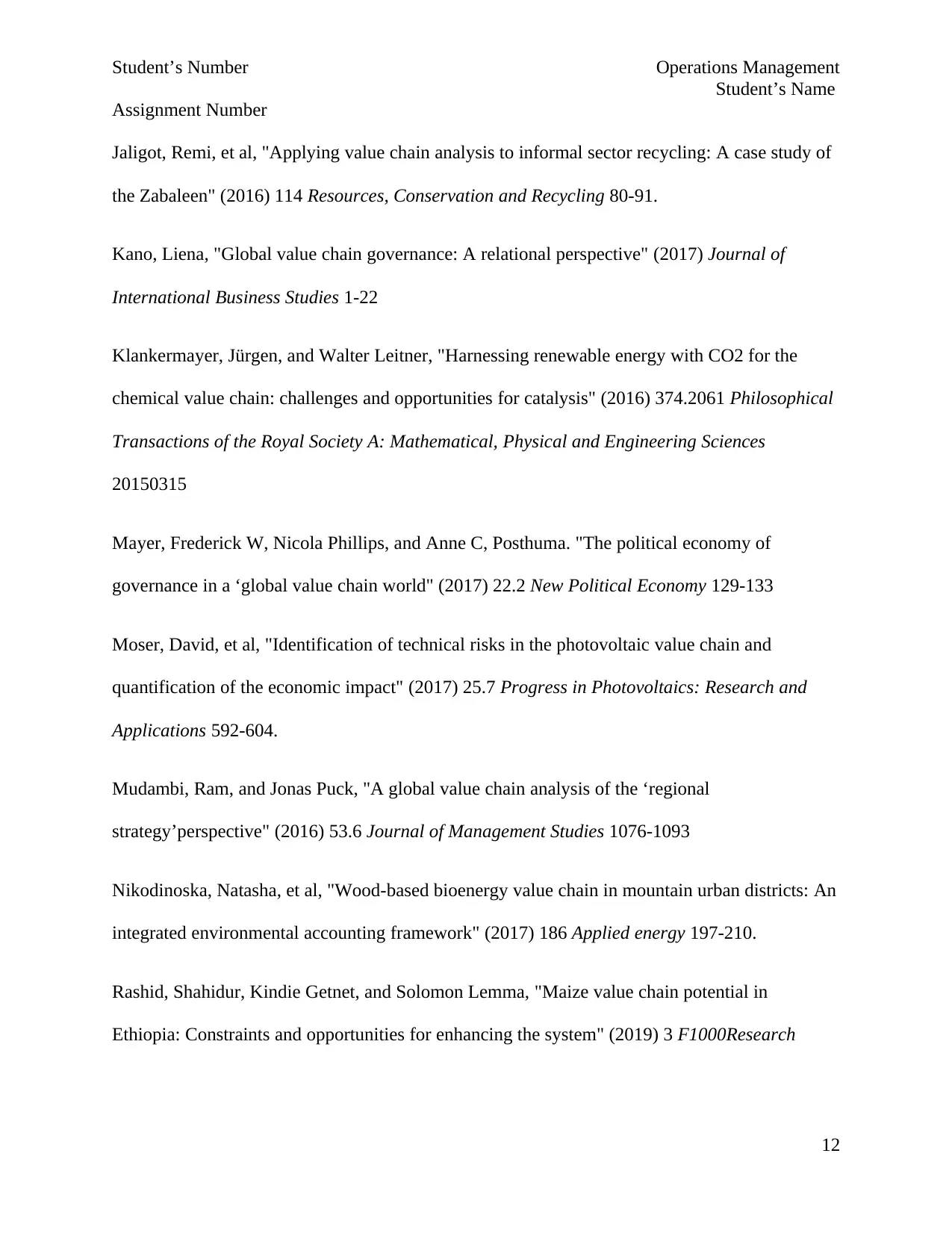
Student’s Number Operations Management
Student’s Name
Assignment Number
Jaligot, Remi, et al, "Applying value chain analysis to informal sector recycling: A case study of
the Zabaleen" (2016) 114 Resources, Conservation and Recycling 80-91.
Kano, Liena, "Global value chain governance: A relational perspective" (2017) Journal of
International Business Studies 1-22
Klankermayer, Jürgen, and Walter Leitner, "Harnessing renewable energy with CO2 for the
chemical value chain: challenges and opportunities for catalysis" (2016) 374.2061 Philosophical
Transactions of the Royal Society A: Mathematical, Physical and Engineering Sciences
20150315
Mayer, Frederick W, Nicola Phillips, and Anne C, Posthuma. "The political economy of
governance in a ‘global value chain world" (2017) 22.2 New Political Economy 129-133
Moser, David, et al, "Identification of technical risks in the photovoltaic value chain and
quantification of the economic impact" (2017) 25.7 Progress in Photovoltaics: Research and
Applications 592-604.
Mudambi, Ram, and Jonas Puck, "A global value chain analysis of the ‘regional
strategy’perspective" (2016) 53.6 Journal of Management Studies 1076-1093
Nikodinoska, Natasha, et al, "Wood-based bioenergy value chain in mountain urban districts: An
integrated environmental accounting framework" (2017) 186 Applied energy 197-210.
Rashid, Shahidur, Kindie Getnet, and Solomon Lemma, "Maize value chain potential in
Ethiopia: Constraints and opportunities for enhancing the system" (2019) 3 F1000Research
12
Student’s Name
Assignment Number
Jaligot, Remi, et al, "Applying value chain analysis to informal sector recycling: A case study of
the Zabaleen" (2016) 114 Resources, Conservation and Recycling 80-91.
Kano, Liena, "Global value chain governance: A relational perspective" (2017) Journal of
International Business Studies 1-22
Klankermayer, Jürgen, and Walter Leitner, "Harnessing renewable energy with CO2 for the
chemical value chain: challenges and opportunities for catalysis" (2016) 374.2061 Philosophical
Transactions of the Royal Society A: Mathematical, Physical and Engineering Sciences
20150315
Mayer, Frederick W, Nicola Phillips, and Anne C, Posthuma. "The political economy of
governance in a ‘global value chain world" (2017) 22.2 New Political Economy 129-133
Moser, David, et al, "Identification of technical risks in the photovoltaic value chain and
quantification of the economic impact" (2017) 25.7 Progress in Photovoltaics: Research and
Applications 592-604.
Mudambi, Ram, and Jonas Puck, "A global value chain analysis of the ‘regional
strategy’perspective" (2016) 53.6 Journal of Management Studies 1076-1093
Nikodinoska, Natasha, et al, "Wood-based bioenergy value chain in mountain urban districts: An
integrated environmental accounting framework" (2017) 186 Applied energy 197-210.
Rashid, Shahidur, Kindie Getnet, and Solomon Lemma, "Maize value chain potential in
Ethiopia: Constraints and opportunities for enhancing the system" (2019) 3 F1000Research
12
⊘ This is a preview!⊘
Do you want full access?
Subscribe today to unlock all pages.

Trusted by 1+ million students worldwide
1 out of 13
Related Documents
Your All-in-One AI-Powered Toolkit for Academic Success.
+13062052269
info@desklib.com
Available 24*7 on WhatsApp / Email
![[object Object]](/_next/static/media/star-bottom.7253800d.svg)
Unlock your academic potential
Copyright © 2020–2025 A2Z Services. All Rights Reserved. Developed and managed by ZUCOL.





